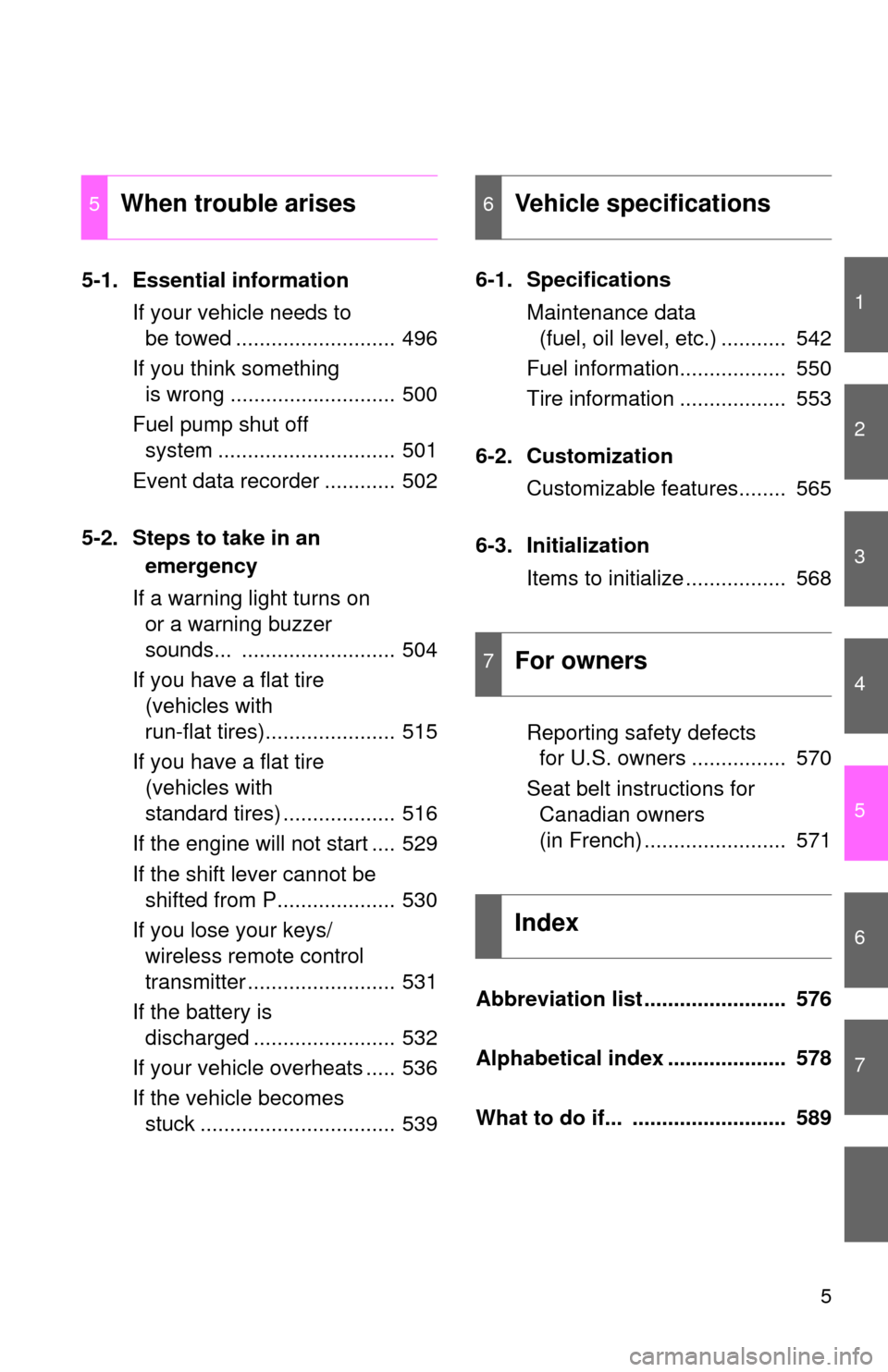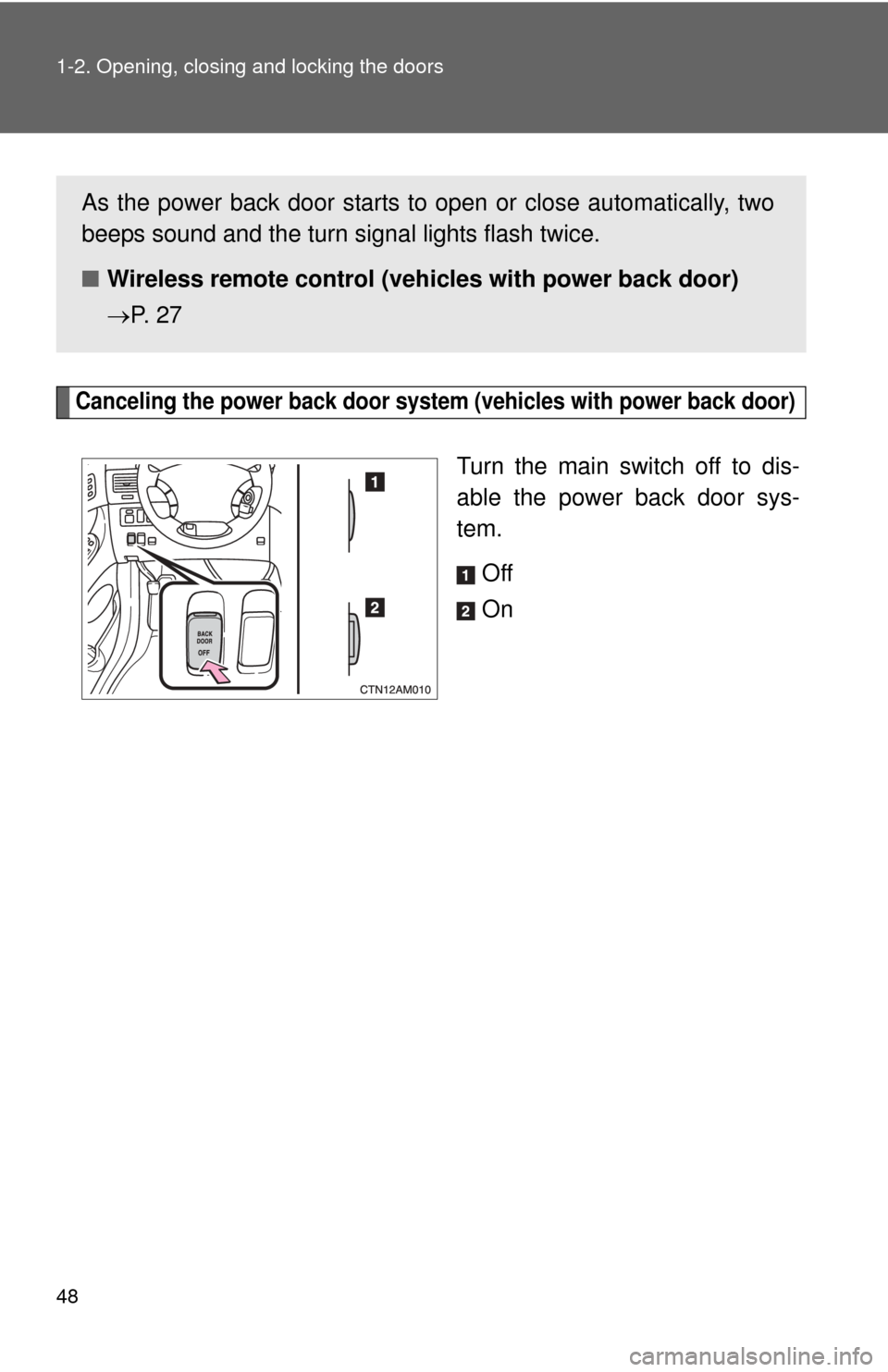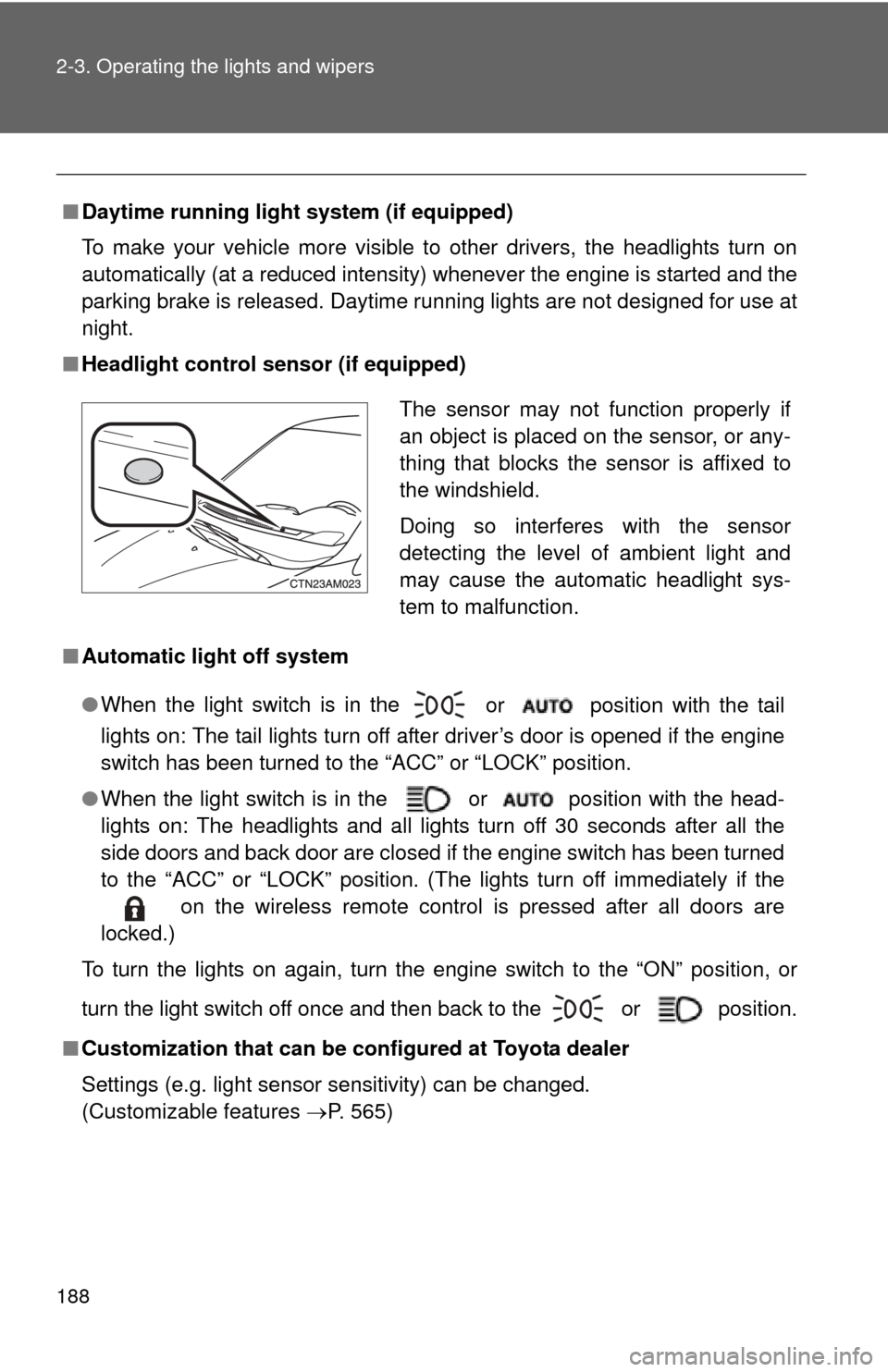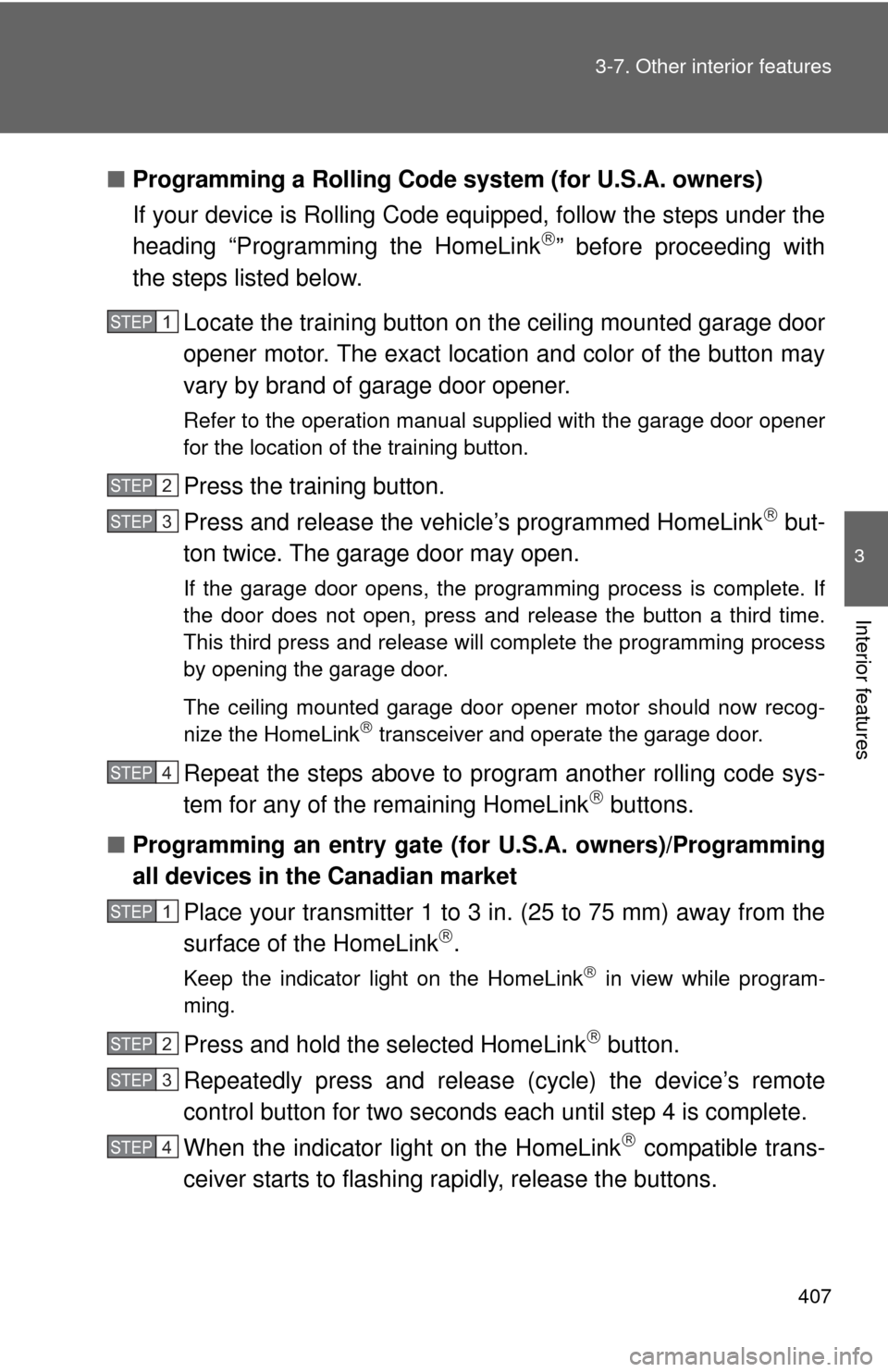2010 TOYOTA SIENNA remote start
[x] Cancel search: remote startPage 5 of 592

1
2
3
4
5
6
7
5
5-1. Essential informationIf your vehicle needs to be towed ........................... 496
If you think something is wrong ............................ 500
Fuel pump shut off system .............................. 501
Event data recorder ............ 502
5-2. Steps to take in an emergency
If a warning light turns on or a warning buzzer
sounds... .......................... 504
If you have a flat tire (vehicles with
run-flat tires)...................... 515
If you have a flat tire (vehicles with
standard tires) ................... 516
If the engine will not start .... 529
If the shift lever cannot be shifted from P.................... 530
If you lose your keys/ wireless remote control
transmitter ......................... 531
If the battery is discharged ........................ 532
If your vehicle overheats ..... 536
If the vehicle becomes stuck ................................. 539 6-1. Specifications
Maintenance data (fuel, oil level, etc.) ........... 542
Fuel information.................. 550
Tire information .................. 553
6-2. Customization Customizable features........ 565
6-3. Initialization Items to initialize ................. 568
Reporting safety defects for U.S. owners ................ 570
Seat belt instructions for Canadian owners
(in French) ........................ 571
Abbreviation list ........................ 576
Alphabetical index .................... 578
What to do if... .......................... 589
5When trouble arises6Vehicle specifications
7For owners
Index
Page 48 of 592

48 1-2. Opening, closing and locking the doors
Canceling the power back door system (vehicles with power back door)
Turn the main switch off to dis-
able the power back door sys-
tem.
Off
On
As the power back door starts to open or close automatically, two
beeps sound and the turn signal lights flash twice.
■Wireless remote control (veh icles with power back door)
P. 2 7
Page 188 of 592

188 2-3. Operating the lights and wipers
■Daytime running light system (if equipped)
To make your vehicle more visible to other drivers, the headlights turn on
automatically (at a reduced intensity) whenever the engine is started and the
parking brake is released. Daytime running lights are not designed for use at
night.
■ Headlight control sensor (if equipped)
■ Automatic light off system
●When the light switch is in the
or position with the tail
lights on: The tail lights turn off after driver’s door is opened if the engine
switch has been turned to the “ACC” or “LOCK” position.
● When the light switch is in the or position with the head-
lights on: The headlights and all lights turn off 30 seconds after all the
side doors and back door are closed if the engine switch has been turned
to the “ACC” or “LOCK” position. (The lights turn off immediately if the
on the wireless remote control is pressed after all doors are
locked.)
To turn the lights on again, turn the engine switch to the “ON” position, or
turn the light switch off once and then back to the
or position.
■ Customization that can be co nfigured at Toyota dealer
Settings (e.g. light sensor sensitivity) can be changed.
(Customizable features P. 565)
The sensor may not function properly if
an object is placed on the sensor, or any-
thing that blocks the sensor is affixed to
the windshield.
Doing so interferes with the sensor
detecting the level of ambient light and
may cause the automatic headlight sys-
tem to malfunction.
Page 301 of 592

301
3-3. Using the rear audio system
3
Interior features
■
Headphones
With some headphones generally available in the market, it may be difficult
to catch signals properly. Toyota recommends the use of Toyota genuine
wireless headphones.
Please contact your Toyota dealer for further details.
■ Vo l u m e
●Adjust the volume when you connect the headphones to the jack. Loud
sounds may have a significant impact on the human body.
● Conversational speech on some DVDs is recorded at a low volume to
emphasize the impact of sound effects. If you adjust the volume assum-
ing that the conversations represent the maximum volume level that the
DVD will play, you may be startled by louder sound effects or when you
change to a different audio source. Be sure to adjust the volume with this
in mind.
CAUTION
■While driving
Do not use headphones.
Doing so may cause an accident, resulting in death or serious injury.
■ When the rear seat entert ainment system is not used
Keep the display closed.
In the event of an accident or sudden braking, the opened display may hit an
occupant's body, resulting in injury.
■ To prevent accidents and electric shock
Do not disassemble or modify the remote controller.
■ When the remote controller is not used
Stow the remote controller.
Injuries may result in the event of an accident or sudden braking.
■ Removed battery and other parts
Keep away from children.
These parts are small and if swallowed by a child they can cause choking.
Page 407 of 592

407
3-7. Other interior features
3
Interior features
■
Programming a Rolling Code sys tem (for U.S.A. owners)
If your device is Rolling Code equipped, follow the steps under the
heading “Programming the HomeLink
” before proceeding with
the steps listed below.
Locate the training button on the ceiling mounted garage door
opener motor. The exact location and color of the button may
vary by brand of garage door opener.
Refer to the operation manual supplied with the garage door opener
for the location of the training button.
Press the training button.
Press and release the vehicle’s programmed HomeLink
but-
ton twice. The garage door may open.
If the garage door opens, the programming process is complete. If
the door does not open, press and release the button a third time.
This third press and release will complete the programming process
by opening the garage door.
The ceiling mounted garage door opener motor should now recog-
nize the HomeLink
transceiver and operate the garage door.
Repeat the steps above to prog ram another rolling code sys-
tem for any of the remaining HomeLink buttons.
■ Programming an entry gate (f or U.S.A. owners)/Programming
all devices in the Canadian market
Place your transmitter 1 to 3 in. (25 to 75 mm) away from the
surface of the HomeLink
.
Keep the indicator light on the HomeLink in view while program-
ming.
Press and hold the selected HomeLink button.
Repeatedly press and releas e (cycle) the device’s remote
control button for two seconds each until step 4 is complete.
When the indicator light on the HomeLink
compatible trans-
ceiver starts to flashing ra pidly, release the buttons.
STEP1
STEP2
STEP3
STEP4
STEP1
STEP2
STEP3
STEP4
Page 495 of 592

When trouble arises5
495
5-1. Essential informationIf your vehicle needs to be towed ........................ 496
If you think something is wrong ......................... 500
Fuel pump shut off system ........................... 501
Event data recorder ......... 502 5-2. Steps to take in an
emergency
If a warning light turns on or a warning buzzer
sounds... ....................... 504
If you have a flat tire (vehicles with
run-flat tires)................... 515
If you have a flat tire (vehicles with
standard tires) ................ 516
If the engine will not start ................................ 529
If the shift lever cannot be shifted from P............ 530
If you lose your keys/ wireless remote control
transmitter ...................... 531
If the battery is discharged ..................... 532
If your vehicle overheats ....................... 536
If the vehicle becomes stuck .............................. 539
Page 581 of 592

581
Alphabetical index
Emergency, in case of
If the back door opener is
inoperative ........................... 49
If the engine will not start...... 529
If the shift lever cannot be shifted ................................ 530
If the vehicle has discharged battery ................................ 532
If the warning buzzer sounds... ........................... 504
If the warning light turns
on ....................................... 504
If you have a flat tire .... 515, 516
If you lose your keys/ wireless remote control
transmitter .......................... 531
If you think something is
wrong ................................. 500
If your vehicle becomes stuck................................... 539
If your vehicle needs to be towed ................................. 496
If your vehicle overheats ...... 536
Engine Compartment........................ 438
Engine switch ....................... 167
Hood ..................................... 434
How to start the engine ................................ 167
Identification number ............ 543
If the engine will not start...... 529
Ignition switch ....................... 167
Overheating .......................... 536 Engine coolant
Capacity ................................546
Checking ...............................444
Preparing and checking before winter ..................................226
Engine coolan t temperature
gauge ......................................174
Engine immobilizer system.....111
Engine oil
Capacity ................................545
Checking ...............................439
Preparing and checking before winter ..................................226
Engine oil maintenance
data .........................................442
Event data recorder .................502
Floor mat...................................401
Fluid Brake .....................................446
Power steering ......................448
Washer ..................................453
Fog lights Replacing light bulbs .............486
Switch....................................190
Wattage .................................549
Front automatic air conditioning system..............246E
F
Page 589 of 592

589
What to do if...
What to do if...
A tire puncturesP. 515/P. 5 1 6If you have a flat tire
The engine does not start
P. 529If the engine will not start
P. 1 1 1Engine immobilizer system
P. 532If the battery is discharged
The shift lever cannot be
moved outP. 530If the shift lever cannot be shifted
from P
The engine coolant temperature
gauge enters the red zone
Steam can be seen coming
from under the hood
P. 536If your vehicle overheats
The key is lostP. 531If you lose your keys/wireless
remote control transmitter
The battery runs outP. 532If the battery is discharged
The doors cannot be locked
P. 3 3Front doors
P. 3 7Siding doors
P. 4 7Back door
The horn begins to soundP. 1 1 3Alarm
The vehicle is stuck in
mud or sandP. 539If the vehicle becomes stuck